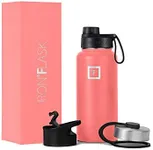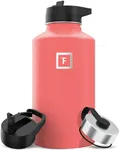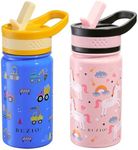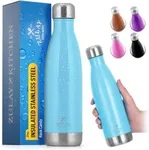Buying Guide for the Best Water Filtration Bottles
Choosing the right water filtration bottle can make a significant difference in your hydration experience, especially if you are often on the go or in areas where water quality is questionable. A good water filtration bottle ensures that you have access to clean, safe drinking water wherever you are. When selecting a water filtration bottle, it's important to consider several key specifications to ensure you get the best fit for your needs.Filtration TechnologyFiltration technology refers to the method used to remove contaminants from the water. This is important because different technologies can filter out different types of impurities. Common technologies include activated carbon filters, UV light, and hollow fiber membranes. Activated carbon is great for removing chlorine and improving taste, UV light can kill bacteria and viruses, and hollow fiber membranes can filter out bacteria and protozoa. Choose a technology based on the type of contaminants you are most concerned about. For example, if you are traveling in areas with questionable water sources, a bottle with a UV light or hollow fiber membrane might be best.
Filter LifespanFilter lifespan indicates how long the filter will last before it needs to be replaced. This is important because it affects the long-term cost and convenience of using the bottle. Lifespan can range from a few hundred to several thousand liters. If you plan to use the bottle frequently, look for a filter with a longer lifespan to avoid frequent replacements. For occasional use, a shorter lifespan might be sufficient.
Flow RateFlow rate measures how quickly water passes through the filter and into your mouth. This is important for convenience and ease of use. A higher flow rate means you can drink more quickly without having to suck hard on the bottle. Flow rates can vary significantly, with some bottles offering a fast, smooth flow and others requiring more effort. If you value quick and easy access to water, look for a bottle with a higher flow rate.
Bottle CapacityBottle capacity refers to the amount of water the bottle can hold. This is important for ensuring you have enough water to stay hydrated. Capacities typically range from around 500 milliliters to over a liter. If you need to carry a lot of water, such as for long hikes or trips, choose a larger capacity bottle. For everyday use or shorter outings, a smaller capacity might be more convenient and lightweight.
Material and DurabilityThe material and durability of the bottle affect its weight, sturdiness, and safety. Common materials include plastic, stainless steel, and glass. Plastic bottles are lightweight and durable but may retain flavors. Stainless steel bottles are very durable and can keep water cool but are heavier. Glass bottles are safe and do not retain flavors but are more fragile. Choose a material based on your priorities, such as weight, durability, and taste.
Ease of CleaningEase of cleaning refers to how simple it is to keep the bottle and its components clean. This is important for maintaining hygiene and ensuring the longevity of the bottle. Some bottles have parts that are dishwasher safe, while others require hand washing. Look for bottles with fewer parts and wide openings for easier cleaning. If you prefer low-maintenance options, choose a bottle that is easy to disassemble and clean.
PortabilityPortability refers to how easy it is to carry the bottle with you. This is important for convenience, especially if you are traveling or hiking. Features that enhance portability include a lightweight design, a carrying handle, and a compact size. If you need a bottle for on-the-go use, look for one that is easy to carry and fits in your bag or backpack.





















